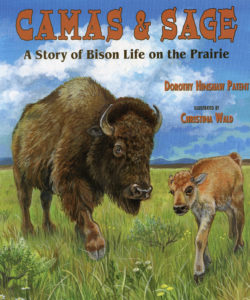 Missoula author Dorothy Patent worked with the American Prairie Reserve to produce this book. She set her story about a bison calf, Camas, on land in central Montana that the organization is dedicated to restoring to a fully functional ecosystem and home to many species of North American native wildlife. The Reserve is particularly interested in restoring a healthy bison population to the area.
Missoula author Dorothy Patent worked with the American Prairie Reserve to produce this book. She set her story about a bison calf, Camas, on land in central Montana that the organization is dedicated to restoring to a fully functional ecosystem and home to many species of North American native wildlife. The Reserve is particularly interested in restoring a healthy bison population to the area.
The story follows Camas and her mother, Sage, through the seasons, detailing their environment, food sources and social interactions with other members of the herd. The author offers ample sidebars with an impressive wealth of facts about these creatures; for example the structure of their feet, their keen sense of smell, herd social structure, mating etiquette, and why buffalo roll (or wallow) in the dirt. Information about prairie habitat and how the bison affected Native American life is also included.
Patent describes the book as “a fun hybrid between fiction and nonfiction,” blending a simple picture book story for young readers with sidebars for older readers, including adults, that offer information about the prairie ecosystem and these long-time inhabitants.
Patent is a longtime Montana resident who has devoted her career to writing nonfiction for young readers. She holds a doctorate in zoology and is the recipient of many awards for her work, including the Washington Post-Children’s Book Guild Nonfiction Award and the Orbis Pictus Honor Book Award. Learn more about her at www.dorothyhinshawpatent.com.
Wald’s illustrations are superb, reflecting the text in a colorful and lifelike manner. An Ohio resident, she has created illustrations for a variety of games, magazines and books, including The Wildlife of Elk.
The American Prairie Reserve is a Montana-based nonprofit that started to assemble land in 2004. The organization’s main focus is to purchase and permanently hold title to private lands that glue together a vast mosaic of existing public lands so that the region is managed thoughtfully and collaboratively for wildlife conservation and public access.
– Judy Shafter